Dal makhani is an extremely popular North Indian vegetarian curry dish of lentils and beans in a spicy and creamy sauce. It's often made for special occasions, and is also sometimes called the Queen of All Dals.
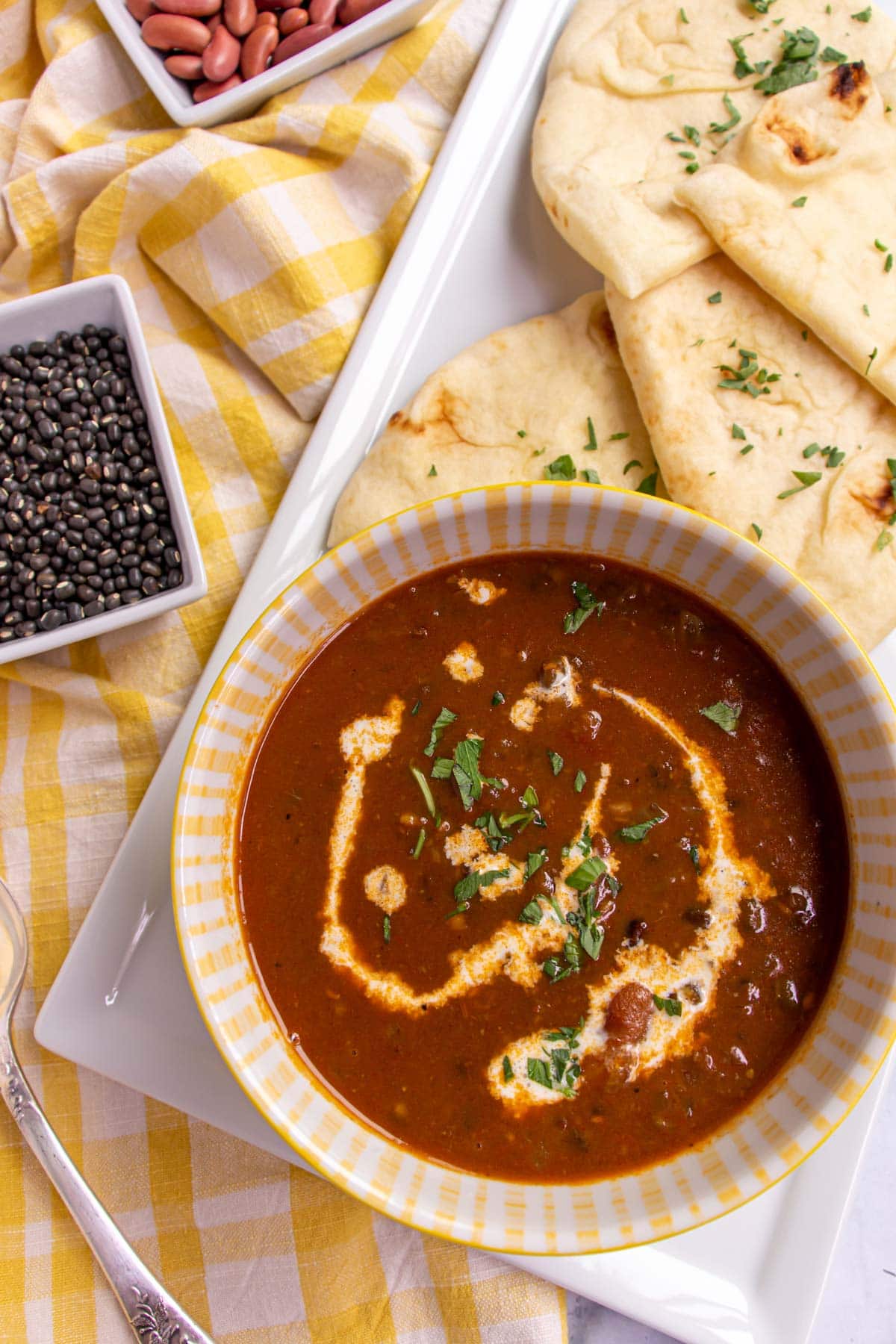
(This recipe was originally published in January 2011, but was updated with new photos and content in 2021).
The term dal refers to pulses (dried lentils, peas or beans) which have been stripped of their outer hulls and split. It also refers to the actual thick stews prepared from these pulses.
Stewed dals are regularly eaten with rice and vegetables in Southern India, and with both rice and roti (wheat-based flatbread) throughout Northern India. The limitless preparations of these dals make vegetarian diets incredibly easy, affordable, and protein-rich.
One of the most famous variations is dal makhani, a popular Punjabi dish from Northern India which is often referred to as the queen of all dals. While some recipes for this North Indian curry require pressure cookers or other special equipment, this recipe does not. Therefore anyone should be able to make it with simple pots and pans.
The word makhani means "butter" so it's not surprising that dal makhani shares many similarities to the ever popular dish of butter chicken (aka murgh makhani). If you're a fan of butter chicken, then definitely consider making this dal makhani recipe the next time you're craving a delicious home-cooked Indian meal.
Ingredient notes
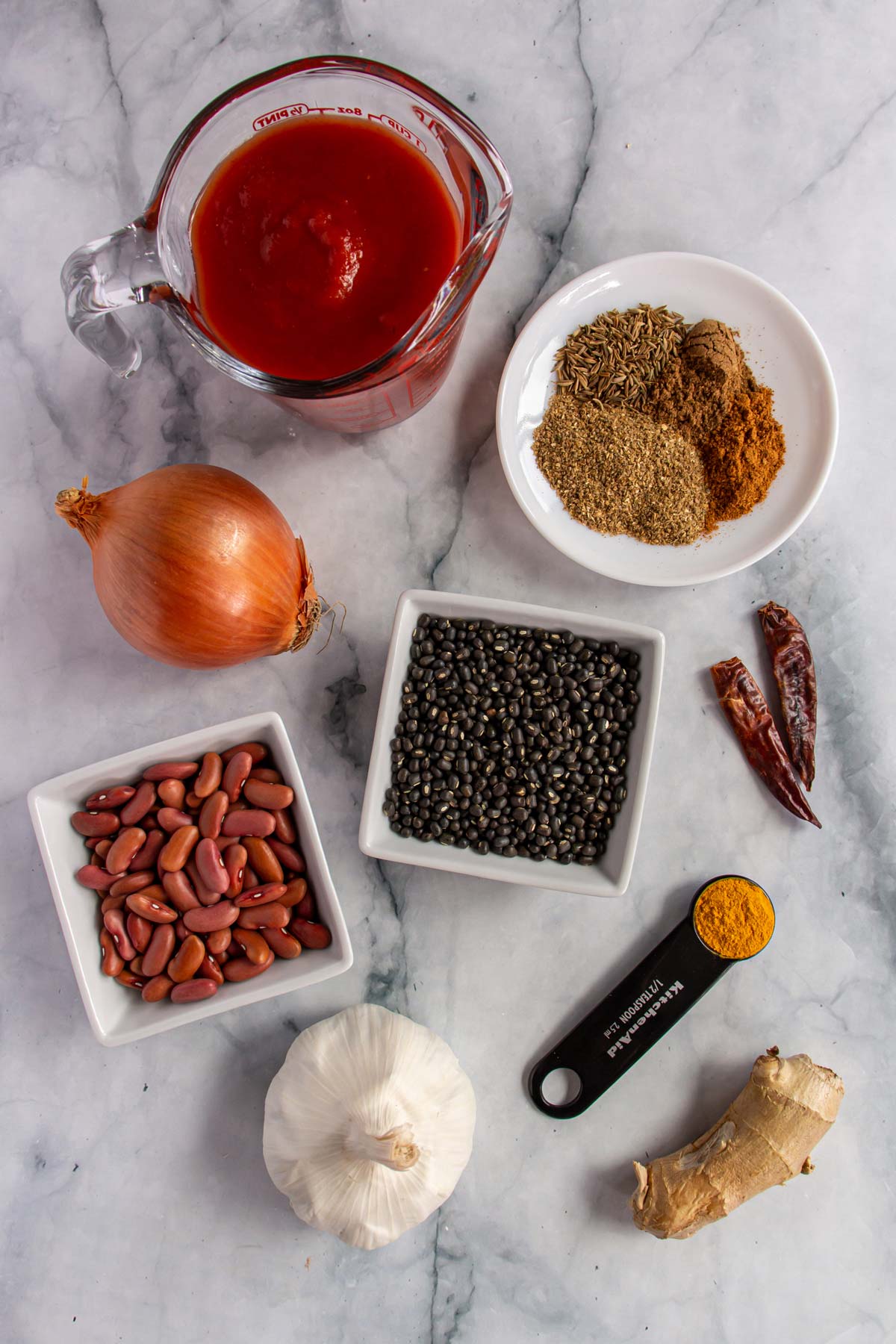
- Urad Dal (Whole Black Gram): The urad dal or whole black gram is really a big part of what makes dal makhani what it is, so I wouldn't recommend substitutions here. However if you struggle to find it in international supermarkets (with other Indian ingredients), you can purchase it online.
- Red Kidney Beans: Dal makhani traditionally uses dry red kidney beans which soak with the urad dal before cooking. If you need to use canned (cooked) kidney beans, drain and rinse the beans well, and plan to use about 3 times as much (around 6 tablespoons cooked beans). Add cooked kidney beans at the same time you add the tomato-spice mixture to the cooked ural dal. Then proceed as directed.
- Indian Red Chilies and Chili Powder: I use dried Indian red chilies and Indian chili powder (listed as medium-hot spice) that I purchased at Kalustyan's Indian grocery store in New York City. You can find these ingredients in well stocked international markets or online as well. In a pinch, use ground cayenne pepper as a substitute, though spice levels may vary.
- Tomato Sauce: I like to use canned tomato sauce for this recipe as it's always consistent, readily available, and easy to use. Bottled tomato puree (passata) or canned crushed tomatoes also work well. In a pinch, stir some tomato paste into water and use that. You could use homemade pureed tomatoes, but they will likely be quite watery. In this case you may need to cook them down more. You may also add a little tomato paste to thicken them up in that case.
- Butter and Cream: This is meant to be a richer dal which even has "butter" in its name. While I highly recommend including the butter, I find the addition of cream is more of a personal preference. Add it for some richness and decadence, but this dal makhani is delicious even without it. The photos in this post are without cream (only a little as garnish).
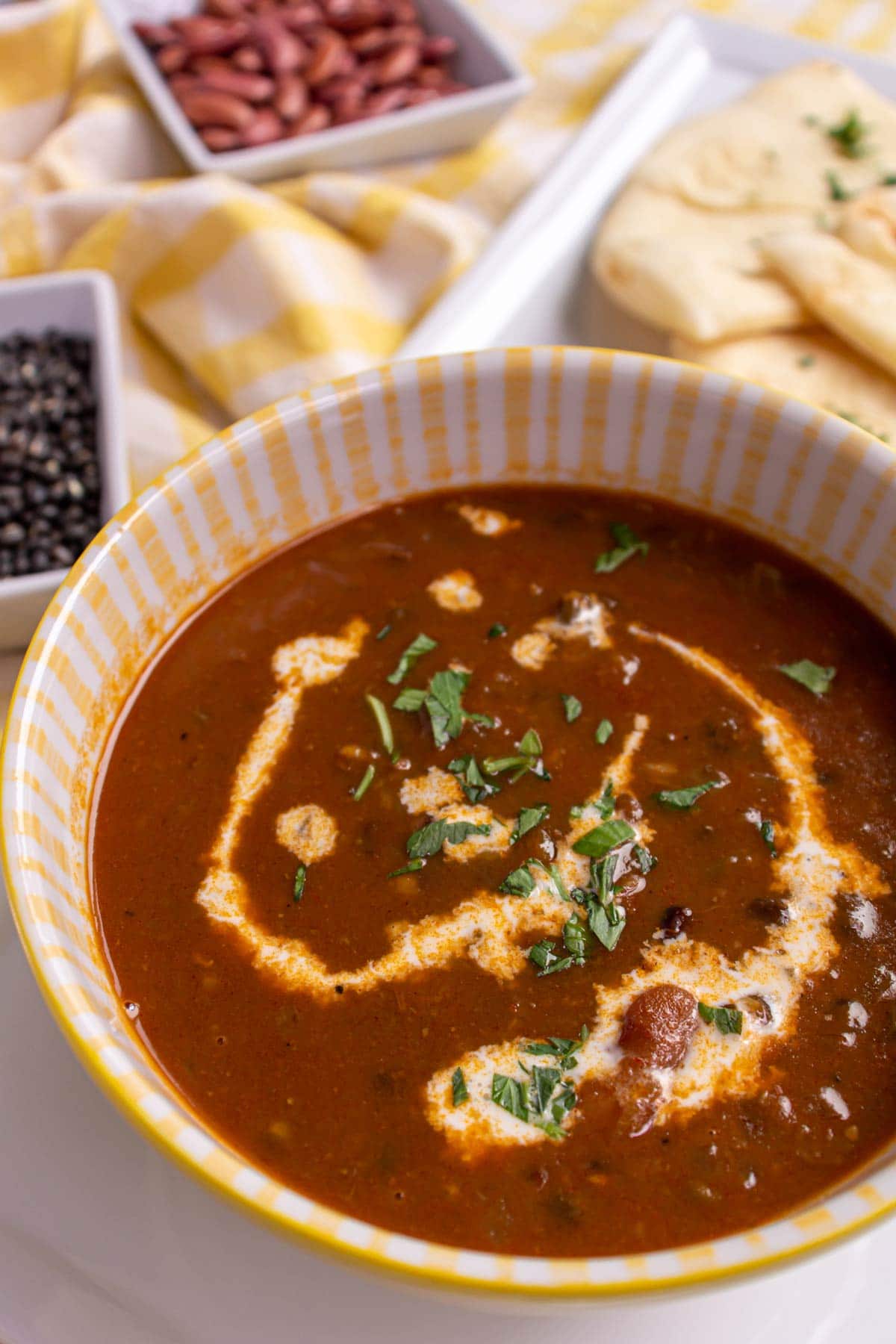
How to make it
Soak both the dals (urad dal and kidney beans) in plenty of cold water for 8 hours or overnight. Rinse well and drain. The urad dal may even look a bit blue after soaking, but this is normal.
Soak the dry red chilies in hot water for 15 minutes and then drain well. Add the reconstituted chilies, ginger, garlic, and a little water to a small food processor. Puree until it forms a smooth paste.
To a medium-large pot add the soaked dals, water, half of the ginger-garlic-chili paste, and the ground turmeric. Bring to a boil over high heat, then reduce the heat to low. Simmer covered for 35 to 45 minutes until the dal is tender. Mash it a little with the back of a spoon, and set aside.
Meanwhile during the last 15 or so minutes of the dal cooking, heat the oil over medium heat in a large sauté pan or skillet. Add the onions and sauté until they start browning, about 10 to 15 minutes.
Add the remaining ginger-garlic-chili paste and sauté for another minute (PHOTO 1). Then add the ground coriander, garam masala, cumin, and chili powder, stirring for a few seconds. Finally, add the tomato sauce and unsalted butter, and cook until the butter melts and the sauce becomes incredibly fragrant, a few minutes more (PHOTO 2).
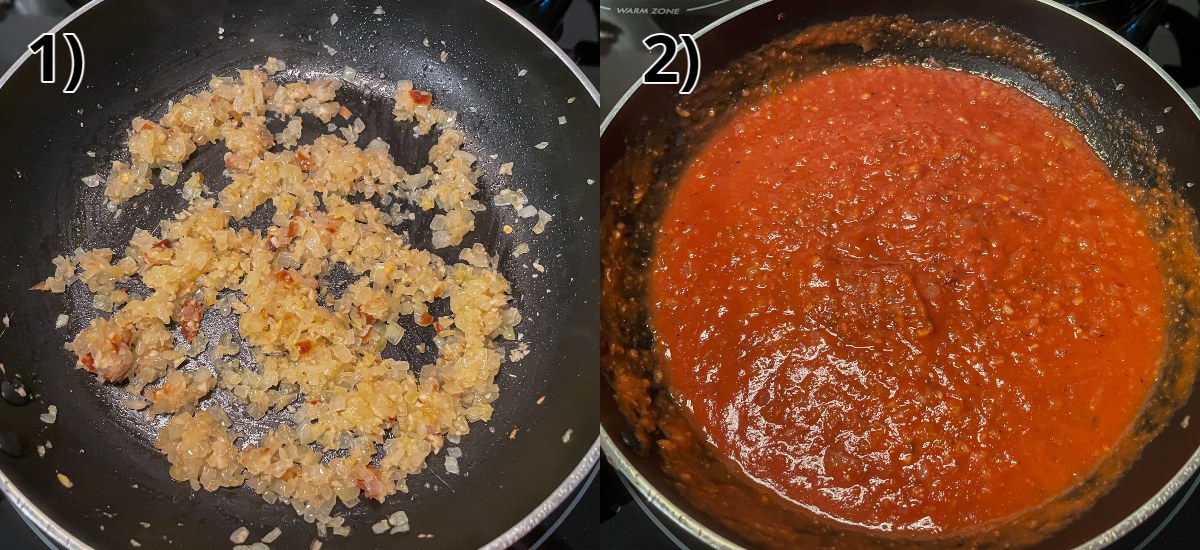
Immediately add this mixture to the pot with the dal and its liquid. Season with salt and bring to a boil. Then lower heat and simmer uncovered for another 15 to 20 minutes, stirring occasionally, until the mixture thickens and the flavors infuse.
Taste and adjust seasoning if necessary. Stir in the heavy cream, if desired, and cook for another 3 minutes.
Please scroll to the bottom of the post for the full recipe (in a printable recipe card) including ingredient amounts and detailed instructions.
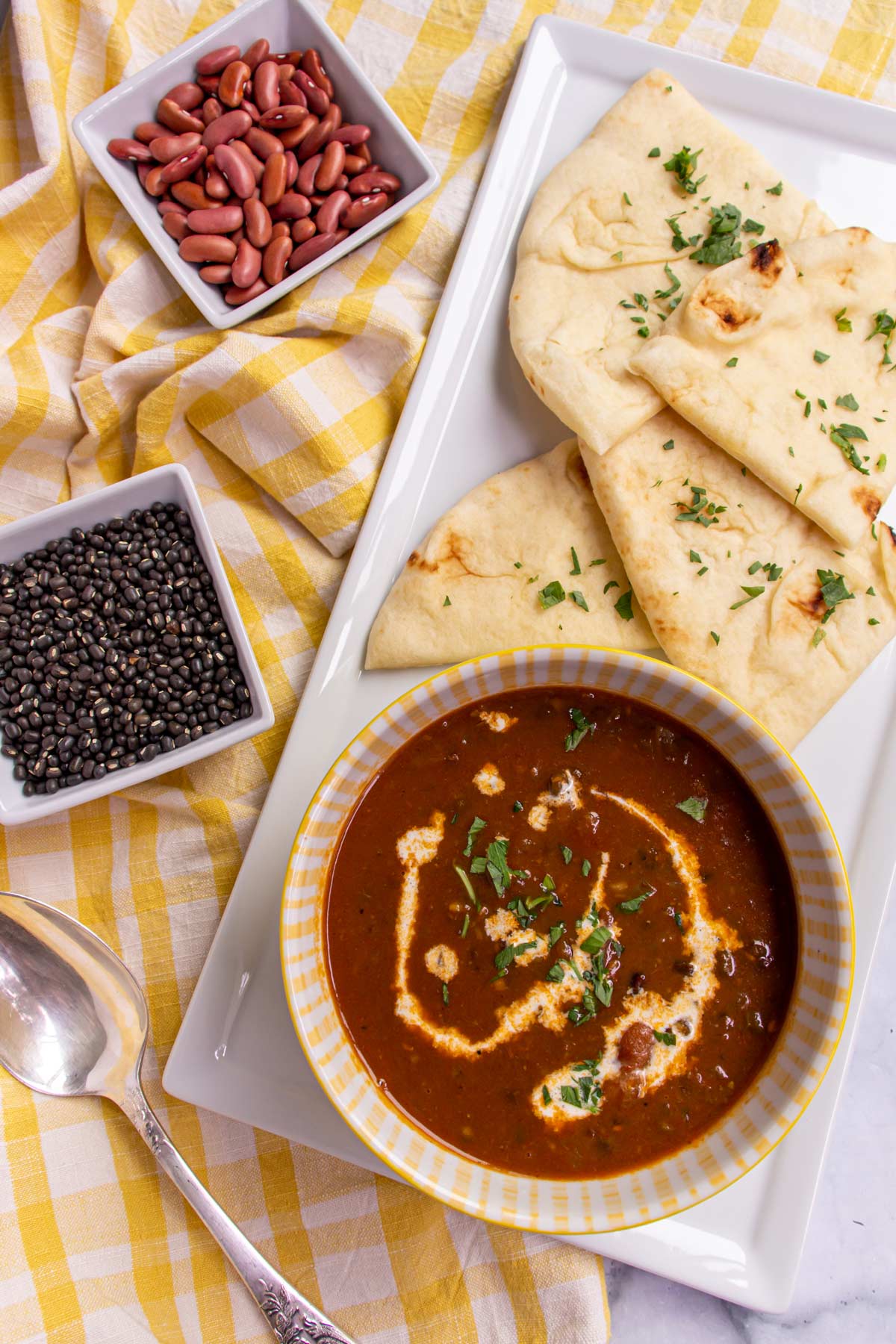
Expert tips
Serve dal makhani with cooked basmati rice or jeera rice (basmati rice with cumin seeds), or any Indian bread such as naan or roti. Enjoy it as a vegetarian centerpiece to your meal, or prepare it alongside other Indian dishes (with meat or meatless) to create a larger Indian menu.
Store leftover dal makhani in a sealed container in the refrigerator for 4 to 5 days. Reheat on the stovetop in a pan or in the microwave in a microwave safe dish. If the consistency thickens during refrigeration, you may thin it out with a little water if desired. For longer storage, you may freeze it in a freezer-safe container for up to 3 months. Thaw overnight in the fridge before reheating.
One of the recipe steps calls to lightly mash some of the lentils and beans with the back of a spoon. This is personal preference how much you want to mash or not. The more you mash, the creamier and thicker your dal will become. The dal makhani in these photos has only been mashed minimally.
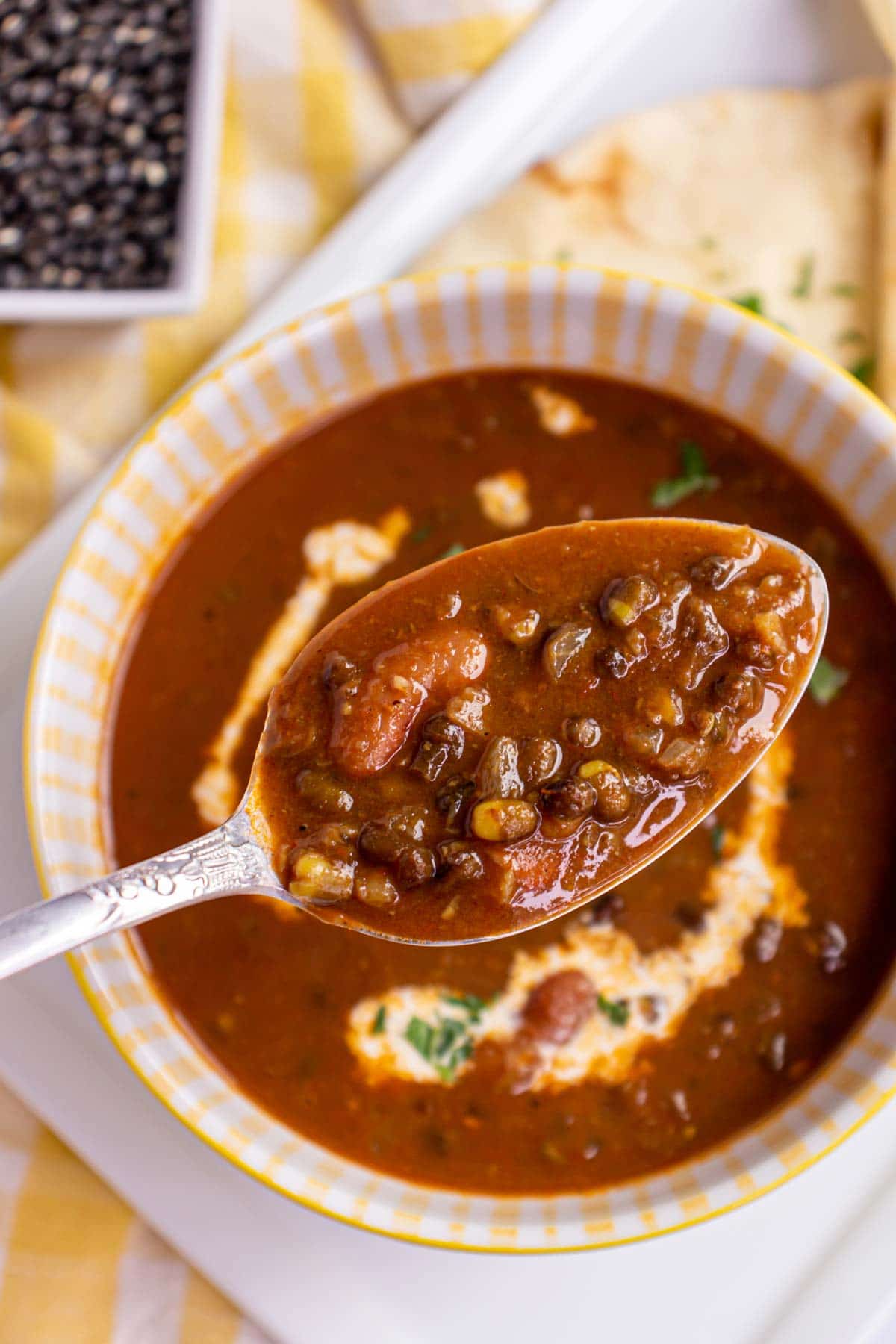
Other recipes you may like
- Chana Dal (Bengal Gram)
- Gajar Matar (Indian Carrots and Peas)
- Aloo Chaat
- Chicken Saag (Indian Chicken and Spinach Curry)
- Chicken Korma (Indian Chicken and Nut Curry)
- Murgh Masala (Chicken Masala)
- Murghi aur Masoor Dal (Bombay-style Chicken with Red Split Lentils)
- Chicken Vindaloo
- Fasolakia (Greek Stewed Green Beans)
Tried this recipe? Please leave a star ⭐️⭐️⭐️⭐️⭐️ rating in the recipe card below and/or a review in the comments section further down the page. You can also follow me on social media on Facebook, Instagram, and Pinterest!
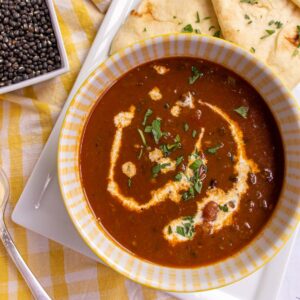
Dal Makhani
Ingredients
- ½ cup urad dal (whole black gram)
- 2 tablespoons dry red kidney beans
- 2 dry Indian red chilies stems removed
- 1- inch piece fresh ginger peeled and roughly chopped
- 6 cloves garlic
- 3 cups plus 2 tablespoons water
- ½ teaspoon ground turmeric
- 1 tablespoon vegetable oil or ghee
- 1 medium onion finely chopped
- 2 teaspoons ground coriander
- 1 teaspoon garam masala
- 1 teaspoon cumin seeds or ground cumin
- ½ teaspoon Indian red chili powder
- 1 cup canned tomato sauce, tomato puree (passata), or crushed tomatoes
- 2 tablespoons butter
- Kosher salt
- 2 tablespoons heavy cream (optional)
Instructions
- Soak both the dals (urad dal and kidney beans) in plenty of cold water for 8 hours or overnight. Rinse well and drain.
- Soak the dry red chilies in hot water for 15 minutes and then drain well. Add the reconstituted chilies, ginger, garlic, and 2 tablespoons water to a small food processor and puree until it forms a smooth paste. (Add a little extra water if needed to get the mixture moving).
- To a medium-large pot add the soaked dals, the remaining 3 cups water, half of the ginger-garlic-chili paste, and the ground turmeric. Bring to a boil over high heat. Reduce the heat to low, and simmer covered for 35 to 45 minutes until the dal is tender. Mash it a little with the back of a spoon or a few times with a potato masher, and set aside.
- Meanwhile during the last 15 or so minutes of the dal cooking, heat the oil over medium heat in a large sauté pan or skillet. Add the onions and sauté until they start browning, about 10 to 15 minutes. Add the remaining ginger-garlic-chili paste and sauté for another minute. Then add the ground coriander, garam masala, cumin, and chili powder, stirring for a few seconds. Then add the tomato sauce and butter, and cook until the butter melts and the sauce becomes incredibly fragrant, a few minutes more.
- Immediately add this mixture to the pot with the dal and its liquid. Season with salt (but not too much as it will reduce) and bring to a boil, then lower heat and simmer uncovered for another 15 to 20 minutes, stirring occasionally, until the mixture thickens and the flavors infuse. Taste and adjust seasoning if necessary. Stir in the heavy cream, if desired, and cook for another 3 minutes. Serve hot with any Indian bread or rice.
Notes
- Store leftover dal makhani in a sealed container in the refrigerator for 4 to 5 days. Reheat on the stovetop in a pan or in the microwave in a microwave safe dish. If the consistency thickens during refrigeration, you may thin it out with a little water if desired. For longer storage, you may freeze it in a freezer-safe container for up to 3 months. Thaw overnight in the fridge before reheating.
- If you need to use canned (cooked) kidney beans, drain and rinse the beans well, and plan to use about 3 times as much (around 6 tablespoons cooked beans). Add cooked kidney beans at the same time you add the tomato-spice mixture to the cooked ural dal. Then proceed as directed.
- I use dried Indian red chilies and Indian chili powder (listed as medium-hot spice) that I purchased at Kalustyan's Indian grocery store in New York City. You can find these ingredients in well stocked international markets or online as well. In a pinch, use cayenne pepper powder as a substitute, though spice levels may vary.
- I like to use canned tomato sauce for this recipe as it's always consistent, readily available, and easy to use.Bottled tomato puree (passata) or canned crushed tomatoes also work well. In a pinch, stir some tomato paste into water and use that. You could use homemade pureed tomatoes, but they will likely be quite watery. In this case you may need to cook them down more. You may also add a little tomato paste to thicken them up in that case.
- Adapted from Padhu's Kitchen
Nutrition
*All nutritional information is based on third-party calculations and should be considered estimates. Actual nutritional content will vary with brands used, measuring methods, portion sizes and more.*







Comments
No Comments